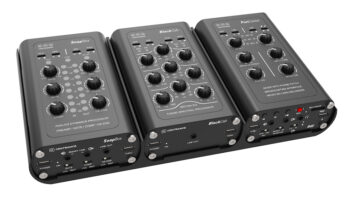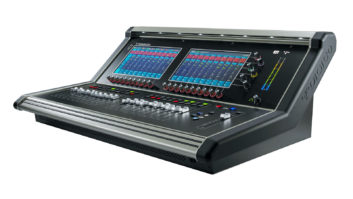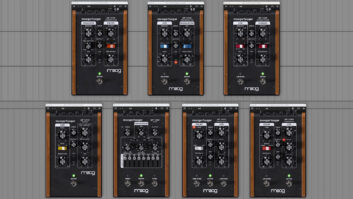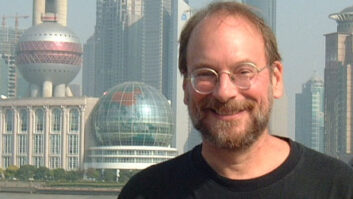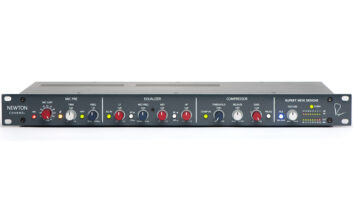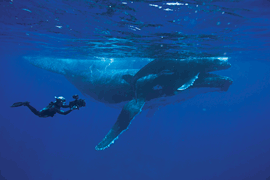

Planet Earth is a production that can surely be called “majestic”: Five years in the making, it was shot on more than 200 locations worldwide by 40 specialist film crews. And the early returns show that the years spent lensing the production (catch a glimpse at www.planet-earth.com) in some of the globe’s most diverse, expansive and demanding environs were worth the effort and the wait. The joint production of this 11-part documentary by The Discovery Channel (TDC) and the BBC is every bit as visually stunning as viewers could want.
At MVI Post in Falls Church, Va., Frank Scheuring is feeling fortunate to have had the opportunity to lend his talents to the mega-show. The senior mixer replaced the original HD audio mix from the BBC’s UK version of the series for the U.S. market to deliver on what was probably the biggest challenge of his young career. Scheuring employed the Fairlight Constellation-XT to replace the original narration track of Sir Richard Attenborough with the voice of actress Sigourney Weaver for domestic air; he also sweetened the rest of the package, which included bonus video for broadcast on Discovery HD Theater channel.
Underwater camerman Doug Allan films mother and baby humpback whales off Tonga in the South Pacific.
Photo: Sue Flood
The first step for Scheuring was to receive the re-edited stems of the separate sounds, including the voice-over, music, effects, split-out and ambient sounds from Discovery production group editor Steven March (via the BBC) so he could get busy with his remix for the 5.1 and stereo mixes. “The BBC did such a great job that it made everything go faster on my end,” he notes.
March and Thom Sulek at Discovery provided Scheuring with OMF and/or AAF files for each of the 11 programs. He received separate files for the “Capturing the Moment” behind-the-scenes shorts from Mary Clare Baquet, producer for those segments. The programs came with full-level stems for music, ambience and effects, along with a track of Weaver’s edited narration.

MVI Post’s Frank Scheuring at the Fairlight Constellation-XT board
“The stems that the BBC provided were excellent,” Scheuring says from his 25×28-foot audio suite at MVI, which includes a Tannoy System 800 Series monitoring system. “Really, it was a matter of creating the surround environment with these awesome sounds that I was given. I always began with Sigourney’s narration track. For Discovery, it was most important that she was out in front and, of course, within their specs for dialog level. After some EQ, compression and a general level setting for her voice, I would move on to the main effects tracks. Since most of these sounds were kept in the front for perspective, I really only had to deal with levels. After that, I would go on to the ambience tracks to fill the room and then move on to the music. The key for the music levels was to accentuate the mood of the score and scene with some movement in the room. The soundtrack to this series is awesome, and it could really affect how you felt about what you were seeing.
The behind-the-scenes short films came with some new music and some effects, but required a lot of sound design prior to mix. “Thankfully, I had Chip Sovek at MVI to help me tackle those,” Scheuring says. “With 11 shorts on top of the 11 episodes, it was a lot of work. The deadline for these was much quicker than for the programs, so we were in high gear. Luckily for us, the shorts only required stereo mixes so that helped with the timeframe.
“If I averaged it out, I probably spent one-and-a-half to two days per episode, both surround and stereo,” he continues. “I spent most of the time on the 5.1 mixes since I could take advantage of the fold-down features in the console. With the Fairlight Constellation XT, I’m able to get a really nice-sounding fold-down from the 5.1 to stereo. After doing the 5.1 mixes and making sure that the LM100 measurements met Discovery’s specs for dialnorm, peak and average levels, I would move on to the stereo side. With the Faders To function on the Constellation, I can select which of my sub-buses I want to tweak and do so without affecting the other buses. Since most of the work had been done while mixing the 5.1, it became a task of meeting guidelines in the stereo world and making sure that Sigourney’s read cut through well enough. Because of the strict specs at Discovery, you really have to watch your meters and be conscious of the ups and downs of the program to keep it as dynamic as possible.
Scheuring says that the Fairlight Constellation-XT, which MVI acquired this past summer to replace its FAME 2 system, was a crucial element in being able to juggle all the tasks required of him on the project. “It’s superfast and super-user-friendly,” he comments, “but it’s the functionality and the sound of the console that I like. On this project, I used only one piece of outboard gear, the Drawmer MX-50 de-esser, on Sigourney’s voice. I didn’t really use reverb except for some of the behind-the-scenes shorts, but I did use Fairlight’s inline EQ with a compressor plug-in. It’s much easier than using a mouse, which I just don’t like the feel of.”
Another reason Scheuring and MVI are bullish on the Fairlight is the increasing amount of HD work they find on the log. “A lot of what we do is in the HD 720p 59.94 format, which Pro Tools does not support,” he says.
Scheuring is quick to point out that Discovery Channel executive producer Maureen Lemire and producer Shannon Malone both simply “let me do my job.” In this case, that encompassed delivering a full stereo mix and a stereo mix-minus of Weaver’s narration from the HDCam 1080i edit master; then two DA-88 tapes, one with a full 5.1 mix and the other with the new stereo stems. “The 5.1 mix gave me more space to work with in my effort to bring the viewer into that sonic landscape,” Scheuring says.
That landscape was as vast as the Earth itself, often viewed from satellite. One clip from the show’s bonus content depicts a cinematographer hiding in the plains just before dawn with his infrared camera. After whispering to his producer that there do not seem to be any lions in the area, his eyebrows suddenly shoot up to his hairline when the rumble of “one of the locals” catches his attention.
The bonus content was an important component of the project for Scheuring as it “offered more of an opportunity for me to be creative. I had to design the sound in that case, not just use the stems that had been sent by TDC. It’s always best for the mixer when he can have that creative input.”
The shows were re-edited once they left the BBC, more in some cases than others, March says, noting that he was cutting from the DA-88s the BBC sent to TDC, “so Frank had the Open Media files to work with on his end.” March says he only added “a few embellishments and a few stingers in certain places, like every time we went to the Earth shots throughout the series to establish locations. We would add the generic space sound effect, a rumble. That was silent for the BBC’s version.”
Though Scheuring was well aware of how important his work on Planet Earth would be to his budding career, he was again reminded of the magnitude of this particular assignment when he got his first look at the footage. “This is the most incredible footage that I’ve ever seen in a nature documentary,” he says, “especially considering what the cinematographers had to go through to get it. It made me want to do my very best job.
Frank R. Smith is freelance writer in the Washington, D.C., area.

WATCH: Additional Scenes

